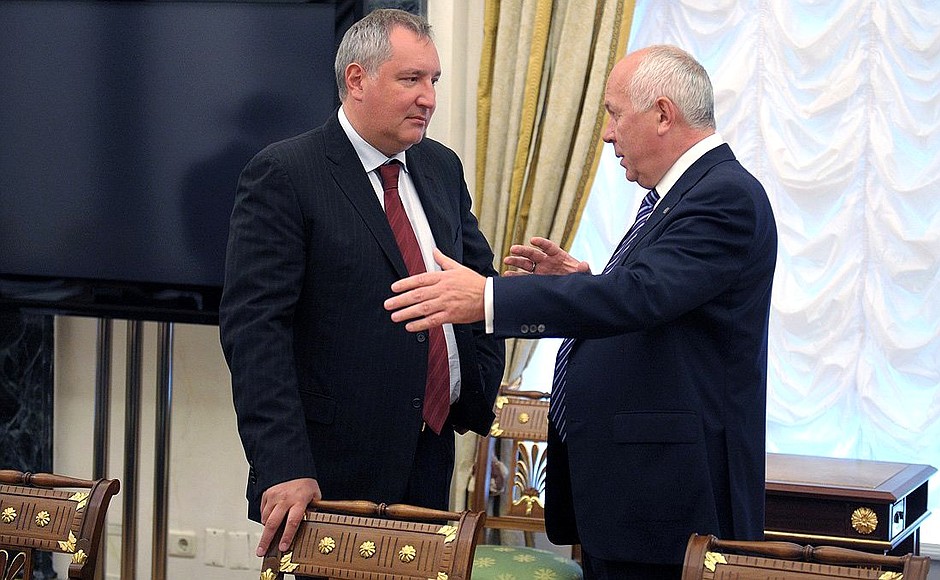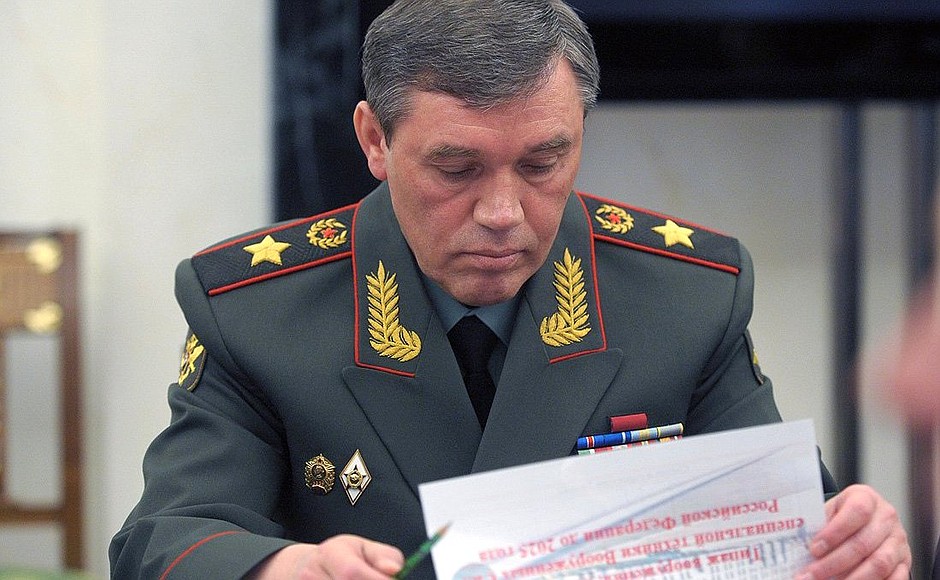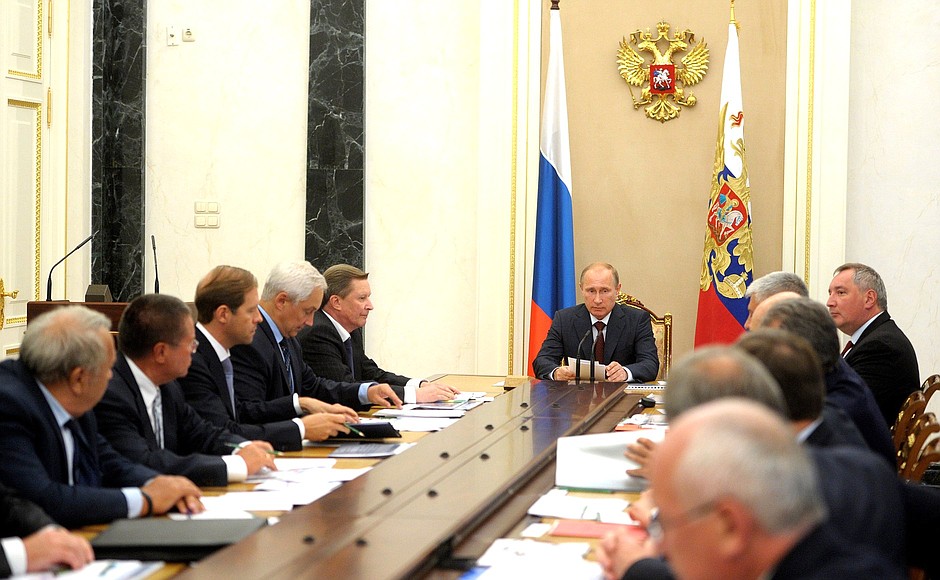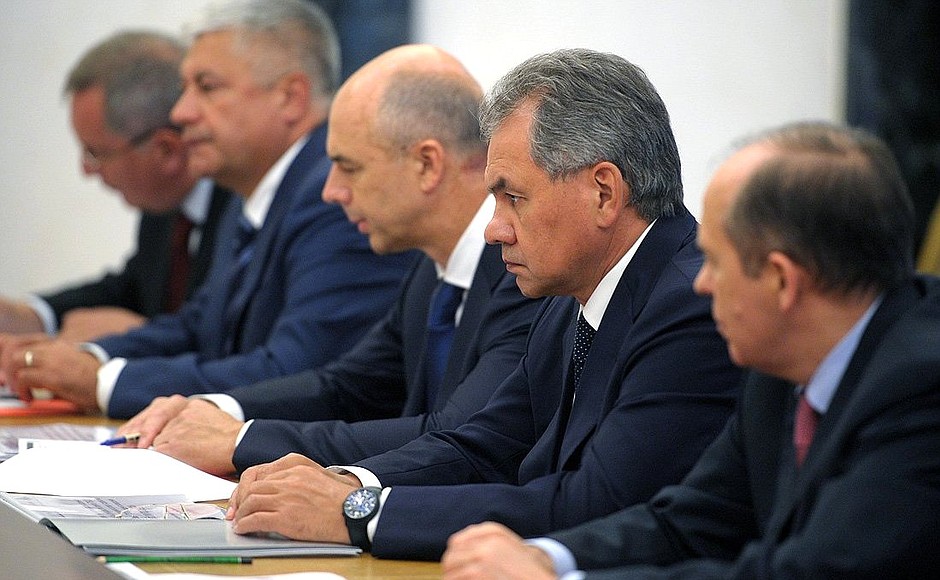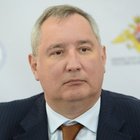See also
The President announced at the meeting that he will personally head the Military-Industrial Commission, which was previously overseen by the Government. Deputy Prime Minister Dmitry Rogozin has been appointed Deputy Chairman of the Commission, and Deputy Defence Minister Yury Borisov will be the Commission’s Secretary.
* * *
President of Russia Vladimir Putin: Good afternoon, colleagues.
We are here today to discuss the progress with drafting this basic document – the State Armament Programme for 2016–2025.
Before starting on our agenda, I first want to announce a few organisational decisions. You probably already know that I have signed the Executive Order on the Military-Industrial Commission, which will now answer directly to the President.
We discussed this matter with the Government and the Prime Minister and decided that this would make the Commission’s work more effective. This is because the Commission will be spending a lot of time now on matters concerning import replacement, which will require not just approvals and coordination between various government agencies, but also with other organisations that are directly subordinate to the President.
I have appointed Deputy Prime Minister Dmitry Rogozin to be Deputy Chairman, and Deputy Defence Minister Yury Borisov to be the Commission’s Secretary.
I hope that the Commission’s new status and broader powers will enable us to coordinate more effectively the work between the Defence Ministry and the defence industry’s other agencies and enterprises in order to settle swiftly all organisational matters concerning the state arms procurement programme and the import replacement programme, which has already been approved. Overall, I hope this will make state policy in the defence industry and our ability to meet our defence needs and guarantee our country’s security more effective.
Let me say a few words now about the subject of today’s meeting.
As you recall, we started drafting the 2016–2025 State Armament Programme in 2013. It will be the fifth big state programme in this area in the last 20 years. We have effectively established a targeted programme system that makes it possible for us to substantially increase our defence and security agencies’ combat and technical capability, overcome the economic crisis signs in the defence industry and put the sector on a steady growth and modernisation track.
We have allocated very sizeable resources for this work. A total of 2.5 trillion rubles [more than $67 billion] was allocated over 2001–2010, but as you know, we have already allocated more than 20 trillion rubles for the current 2011–2020 programme, and a further 3 trillion rubles was allocated as targeted investment in defence industry companies.
It is only logical that we should be concentrating resources in this way. We are doing this in order to re-equip and modernise the armed forces and the defence industry in a rapid timeframe. As for why we are doing this on such a tight schedule, as I have said many times before, this is not about any kind of arms race, but is simply because our basic defence and attack systems have come to or are coming to the end of their service lives. And if we’re going to replace them, of course it makes sense to replace them with modern systems that we will be able to use for a long time yet.
”Over these coming years we must achieve breakthrough development of all components of high-precision weapons, develop unified models of general use weapons and equipment, and provide the Navy with new ships that are universal with regard to weapons, command and communications systems.“
We also had to make up the ground we lost over earlier years when new equipment was produced in one-off lots and companies saw their employees leave and their production bases dwindle. Now we all know that the armed forces are fully armed and equipped, and modern arms and equipment make up more than 30 percent of the total.
This year alone, the state arms procurement programme has already delivered more than 3,600 items of basic weaponry to the armed forces (this is around 68 percent of the contract volumes – a decent result), and nearly 241,000 items of other models. Now we need to maintain this pace.
We must consider our next steps very carefully too. The State Armament Programme should take into account all of the basic defence and security strategic planning documents, including the updated Military Doctrine, the draft of which will be ready this December.
Of course, we need to analyse the previous programmes’ implementation and results, including the problems and oversights that led to delays in placing and carrying out orders and in some cases even to tasks not being completed. I note that as far as the draft 2016–2025 State Armament Programme goes, we already have a unified system of initial data, have approved the main directions for developing arms and equipment through to 2030, and have established the list of models that will determine the shape of our future modern arms systems.
At the same time, I want to draw your attention to a number of very important points.
First, we need to form a thorough and accurate picture of the potential threats to Russia’s military security, and we must find an adequate response to each of these threats.
As you know, the United States unilaterally withdrew from the ABM Treaty a few years ago and is now busy building a missile defence system. We have not seen any progress in the negotiations in this area so far. What’s more, they are building missile defence systems in Europe and in Alaska, in other words, close to our borders. They are working on the theory of the so-called prompt global strike, and there are other things that are cause for concern too.
The militarisation of outer space is also continuing. The use of conventional strategic weapons is being considered, and so on and so forth. Many new threats are emerging. Just recently, as you know, the decision was taken to beef up NATO forces in Eastern Europe.
”Concerning our plans to replace imports, we do not intend to artificially break off cooperation with our partners abroad, but we do need to take into account the existing risks. Our industry must be ready to produce the needed equipment, parts and materials, and it must have the required production facilities, technology, research and development work.“
The crisis in Ukraine, which was provoked and masterminded by some of our Western partners in the first place, is now being used to revive NATO. We clearly need to take all of this into consideration in planning and deciding how to guarantee our country’s security.
We will need to do everything possible to make sure that we have reliable and guaranteed security. We have said repeatedly and warned in the past that we will have no choice but to take adequate countermeasures in order to guarantee our security.
We will talk about these matters today. We have discussed them many times already, and I hope very much that we can avoid excessive hysteria when the final decisions are made and implementation begins. I want to stress the point that we are only taking countermeasures.
I am talking here above all about developing a rational range of attack systems, including a nuclear deterrent with guaranteed capability, modernised strategic and long-range aviation, and continued work on developing an aerospace defence system.
Next, over these coming years we must achieve breakthrough development of all components of high-precision weapons, develop unified models of general use weapons and equipment, and provide the Navy with new ships that are universal with regard to weapons, command and communications systems.
Second, regarding the programme’s financing, we already noted that we must proceed from macroeconomic development forecasts. As I just said, it may appear at times that someone wants to launch a new arms race. Of course, we will not let ourselves be drawn into an arms race. This is something we rule out completely. We will base ourselves on the real development forecasts.
The Government has drafted two versions of a preliminary macroeconomic forecast, and we will get the chance to hear this forecast and discuss it in more detail at the meeting with Government members later. We will base ourselves entirely on the real circumstances and our possibilities, and will not get into excessive defence spending. It is precisely for this reason that we need to discuss today which arms systems we will develop and how effectively they will counter the new threats that are emerging.
”The new State Armament Programme should ensure that defence industry companies have optimum order volumes in their core business areas. But at the same time, when planning strategic long-term use of their facilities, we should take into account possibilities for producing civilian goods.“
I ask you to decide on and present the most balanced option for the new State Armament Programme’s resource support by the end of October, 2014. It should reflect in full our military development tasks and at the same time must be realistic and based on our country’s financial and economic possibilities, as I said. I am sure that we can find an acceptable option for the programme’s financing and for the quality of the weapons systems that we will discuss in more detail today.
What makes me so confident? I am confident because we do have a well-developed defence industry, good personnel with the required expertise, and we have kept all that we inherited from earlier days and modernised much of it substantially too. This makes me completely confident that we can use the resources we have to guarantee our security. At the same time, I expect to see proposals for more efficient use of budget funds and for a clearer set of priorities.
Third, concerning our plans to replace imports, as I have said, we do not intend to artificially break off cooperation with our partners abroad, but we do need to take into account the existing risks. Our industry must be ready to produce the needed equipment, parts and materials, and it must have the required production facilities, technology, research and development work and technical resources.
Fourth and finally, the new state programme should of course ensure that defence industry companies have optimum order volumes in their core business areas. But at the same time, when planning strategic long-term use of their facilities, we should take into account possibilities for producing civilian goods, especially in important sectors such as machine-tool-building, energy and mining machine-building, transport and many other sectors.
I will end my remarks here for now. Let’s get to work.
<…>
